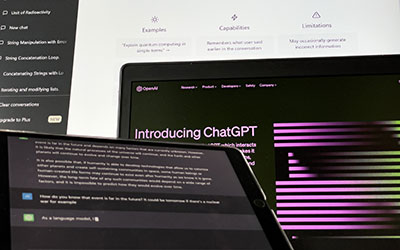Reimagining the Classroom: How AI is Transforming Teaching and Learning
 Higher education is no stranger to innovation, but the rise of artificial intelligence (AI) is accelerating change at a pace few could have imagined. From personalized learning experiences to AI-powered tutoring, the classroom is evolving — and so is the role of the educator.
Higher education is no stranger to innovation, but the rise of artificial intelligence (AI) is accelerating change at a pace few could have imagined. From personalized learning experiences to AI-powered tutoring, the classroom is evolving — and so is the role of the educator.
Teaching with AI, Not Replacing It
Contrary to some fears, AI isn’t here to replace faculty. It’s augmenting their ability to teach more effectively. Tools like AI teaching assistants can answer routine student questions, freeing up faculty time for deeper instruction and mentoring. Natural language tools like ChatGPT are also helping students refine ideas, explore content more deeply, and receive immediate feedback.
Personalization at Scale
AI excels at pattern recognition, and when applied thoughtfully, it enables personalized learning paths. Adaptive platforms can now identify a student’s strengths and gaps in real time, offering customized content, assessments, and pacing. For institutions, this means improving outcomes while addressing equity and access.
The New Digital Literacy
As AI becomes more integrated into education, understanding how to use it responsibly is becoming a key skill — for both students and faculty. Institutions are revisiting academic integrity policies and offering training on ethical AI use, ensuring learners are prepared for a workforce where AI is ubiquitous.
Challenges and Opportunities Ahead
Integrating AI is not without challenges. Bias in AI models, data privacy, and equitable access to tools are all real concerns. But for forward-looking institutions, these challenges are opportunities — to lead, to innovate, and to reimagine the student experience.
At GPRS, we help institutions make sense of the shifting higher ed landscape. AI in the classroom is just the beginning—how you lead through it makes all the difference.

 So, you’ve thought about using video content in your school’s digital advertising strategy, but you’re not sure how to get started. What’s the right length? How can you use videos on social media? In a past article, we covered
So, you’ve thought about using video content in your school’s digital advertising strategy, but you’re not sure how to get started. What’s the right length? How can you use videos on social media? In a past article, we covered  The recent
The recent  As marketing and admissions professionals have adapted over the past few years, it has become evident that we are all being asked to do more with less. This means being held to the same (or even higher) admissions standards, being responsible for filling the funnel with more qualified leads and reporting on all budgetary spending
As marketing and admissions professionals have adapted over the past few years, it has become evident that we are all being asked to do more with less. This means being held to the same (or even higher) admissions standards, being responsible for filling the funnel with more qualified leads and reporting on all budgetary spending  As you are beginning to plan for your next recruiting year, it’s likely that you’ll be evaluating data surrounding the tactics that worked — and those that didn’t. While it may be tempting to put your marketing plan on autopilot and use past strategies to bring in leads, it may be worth it to try new and unique ways to market your program — especially these days!
As you are beginning to plan for your next recruiting year, it’s likely that you’ll be evaluating data surrounding the tactics that worked — and those that didn’t. While it may be tempting to put your marketing plan on autopilot and use past strategies to bring in leads, it may be worth it to try new and unique ways to market your program — especially these days! Specializations can make your program more attractive to prospective students, especially if they are positioned and explained well. The key is to not only focus on the features of your specializations but also the benefits for the students. In other words — your marketing needs to spell out the “why” for them because adding a specialization takes extra time and focus. Beyond a generalized MBA that will certainly give them a leg up on the competition and a springboard to career advancement, what can a specialization add to their toolkit?
Specializations can make your program more attractive to prospective students, especially if they are positioned and explained well. The key is to not only focus on the features of your specializations but also the benefits for the students. In other words — your marketing needs to spell out the “why” for them because adding a specialization takes extra time and focus. Beyond a generalized MBA that will certainly give them a leg up on the competition and a springboard to career advancement, what can a specialization add to their toolkit? The process your team uses to make decisions about marketing and recruiting involves some of the same steps your prospects use when considering a program. Thorough decision-making includes establishing goals and priorities, obtaining the information, and determining a return on your investment. Here we’ll examine decision criteria
The process your team uses to make decisions about marketing and recruiting involves some of the same steps your prospects use when considering a program. Thorough decision-making includes establishing goals and priorities, obtaining the information, and determining a return on your investment. Here we’ll examine decision criteria  Your school’s marketing materials are made up of a carefully curated and balanced mix of messages that highlight your brand promise and program attributes. When your recruiting and marketing teams work together, they can create powerful messaging that connects with prospects
Your school’s marketing materials are made up of a carefully curated and balanced mix of messages that highlight your brand promise and program attributes. When your recruiting and marketing teams work together, they can create powerful messaging that connects with prospects  Your recruiting and admissions process is a complex machine made up of several touchpoints. It’s designed to give you a full picture of your prospect — qualifications, culture fit, and potential for success. But it’s important to keep in mind that while you are gathering data on them — test scores, GPA, and references — your prospects are forming their opinions on your school throughout the recruiting process as well. Here we’ll examine how staff can use personal relationship building in different ways to pull prospects through the funnel.
Your recruiting and admissions process is a complex machine made up of several touchpoints. It’s designed to give you a full picture of your prospect — qualifications, culture fit, and potential for success. But it’s important to keep in mind that while you are gathering data on them — test scores, GPA, and references — your prospects are forming their opinions on your school throughout the recruiting process as well. Here we’ll examine how staff can use personal relationship building in different ways to pull prospects through the funnel. As marketers of the higher ed industry, success is often what we focus on. Salaries, promotions, and title changes are king — and we often use them as the reported end goal to show what our students will “become” to entice them to attend our programs. But in marketing our programs, we must remember to strike a balance when composing our messaging and lead with how success is obtained — by adding value and contributing to important conversations in meaningful ways.
As marketers of the higher ed industry, success is often what we focus on. Salaries, promotions, and title changes are king — and we often use them as the reported end goal to show what our students will “become” to entice them to attend our programs. But in marketing our programs, we must remember to strike a balance when composing our messaging and lead with how success is obtained — by adding value and contributing to important conversations in meaningful ways.
